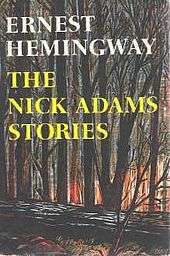The Nick Adams Stories

The Nick Adams Stories is a volume of short stories written by Ernest Hemingway published in 1972, a decade after the author's death. In the volume, all the stories featuring Nick Adams, published in various collections during Hemingway's lifetime, are compiled in a single collection. The Nick Adams Stories includes 24 stories and sketches, eight of which were previously unpublished. Some of Hemingway's earliest work such as "Indian Camp" is represented, as well as some of his best known stories such as "Big Two-Hearted River".[1]
The volume is divided into five sections titled "Northern Woods", "On His Own", "War", "Soldier Home" and "Company of Two". "Northern Woods", includes "Three Shots", "Indian Camp", "The Doctor and the Doctor's Wife", "Ten Indians" and "The Indians Moved Away".
The next section, "On His Own", includes "The Light of the World", "The Battler", "The Killers", "The Last Good Country", and "Crossing the Mississippi".
The third section titled "War" has "Night Before Landing", "Nick sat against the wall….", "Now I Lay Me", "A Way You'll Never Be", "In Another Country" and "Soldier's Home".
The next section is titled "Soldier Home", and includes "Big Two-Hearted River", "The End of Something", "The Three-Day Blow", and "Summer People".
The volume ends with the section "Company of Two" with "Wedding Day", "On Writing", "An Alpine Idyll", "Cross-Country Snow" and "Fathers and Sons".
Published after he died in 1961, like his other posthumous work, The Nick Adams Stories may have been reworked and edited in a manner he never intended.[2] One reviewer for The New York Times had this to say about one of the stories "Three Shots", a section Hemingway originally cut from "Indian Camp" – one of his earliest stories first published in 1925 volume In Our Time:
Alone, "Three Shots" stands as a vignette of a boy's fear, accorded sympathy by his father and impatience by his uncle. As part of the stark and spare "Indian Camp," however, it was clearly excess baggage and, knowing that it was cut out, one can only read it with admiration for the nascent and ruthlessly true artistic impulse that caused its excision.[1]
Contrary to the above are those who welcome publication of the new Nick Adams material which fills in chronological gaps of the autobiographical character's experience, and thus shows much of Hemingway's own life that remained unpublished.[3]
Notes
- 1 2 Lingeman, Richard (April 25, 1972). "More Posthumous Hemingway". The New York Times. Retrieved 2009-10-22.
- ↑ Nicolette Jones (3 Jul 2009). "Fame beyond the grave". Telegraph. Retrieved 2010-01-15.
- ↑ "The Nick Adams Stories". The Victoria Advocate. April 16, 1972. Retrieved 2010-01-15.
References
- Baker, Carlos (1972). Hemingway: The Writer as Artist (4th ed.). Princeton University Press. ISBN 0-691-01305-5.
- Burwell, Rose Marie. Hemingway: the postwar years and the posthumous novels. New York: Cambridge University Press. ISBN 0-521-48199-6. Retrieved 2009-12-11.
- Hannum, Howard (2001). "'Scared sick looking at it': A Reading of Nick Adams in the Published Stories". Twentieth Century Literature. 47 (1): 92–113. doi:10.2307/827858.
- Meyers, Jeffrey (1985). Hemingway: A Biography. London: Macmillan. ISBN 0-333-42126-4.
- Mellow, James R. (1992). Hemingway: A Life Without Consequences. New York: Houghton Mifflin. ISBN 0-395-37777-3.
- Oliver, Charles M. (1999). Ernest Hemingway A to Z: The Essential Reference to the Life and Work. New York: Checkmark. ISBN 0-8160-3467-2.